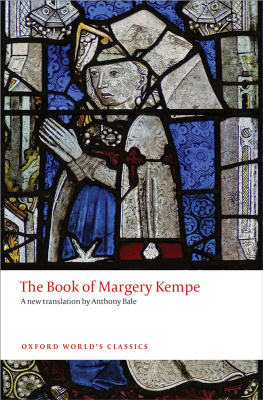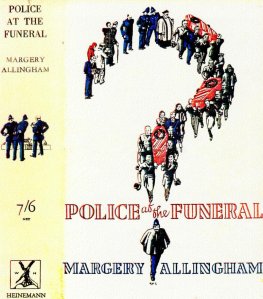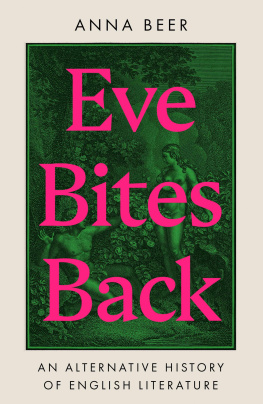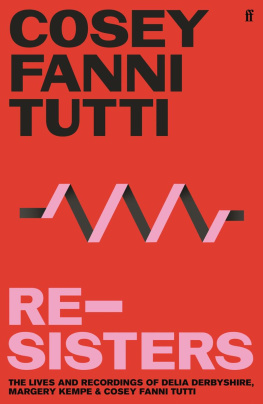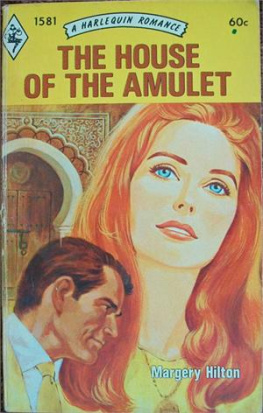
Translated and Edited by
B. A. WINDEATT
THE BOOK OF MARGERY KEMPE

Contents
About the Authors
MARGERY KEMPE , born c.1373 of well-to-do middle-class parentage in Kings Lynn in Norfolk, was married at twenty, had a vision of Christ in her mental illness following her first childbirth, and, after early failures as a businesswoman, saw visions and heard voices, and felt herself called to a spiritual life. At about the age of forty, when she had borne fourteen children, she persuaded her husband to join her in a mutual vow of chastity, and then embarked on an eventful life of pilgrimage in England, Europe and the Holy Land, visiting both great and humble religious figures of her day, ceaselessly seeking the counsel of mystics and recluses. Always a controversial figure, her devotion characteristically expressed itself in loud weeping and cries, which often divided priests, congregations and fellow pilgrims into friends or enemies, and she was several times in danger of being burned at the stake as a heretic. Towards the end of her life, she dictated in an account of her travels and visions her spiritual autobiography, and the rediscovery of a unique manuscript in 1934 restored to English literature the earliest form of autobiographical writing in English.
B. A. WINDEATT is a Fellow of Emmanuel College, Cambridge.
Botte for I am a woman, schulde I therfore leve that I schulde nought telle yowe the goodenes of God?
Dame Julian of Norwich,
Revelations of Divine Love (Shorter Version)
For trusteth wel, it is an impossible
That any clerk wol speke good of wyves,
But if it be of hooly seintes lyves
By God! if wommen hadde writen stories,
As clerkes han withinne hire oratories,
They wolde han writen of men moore wikkednesse
Than al the mark of Adam may redresse
Geoffrey Chaucer, The Wife of Baths Prologue
Chronology
c.1373 Birth of Margery, daughter of John Brunham.
c.1393 Marriage (aged twenty or somewhat more) to John Kempe ().
c.1409 Gives up eating meat ().
c.140910 Prays to end sexual relations with her husband; this is granted three or four years afterwards ().
c.1411 Divinely commanded to go to Rome, Jerusalem and Santiago de Compostela, two years before departing ().
c.1413 Arrival of the young priest who reads to her from the Bible and many a good book of high contemplation over a period of seven or eight years ().
1413 Summoned before the Bishops officers in Norwich and supported by Richard of Caister (d. 1420), seven years before his death ().
June: Visits York and Bridlington.
23 June: Agreement with her husband to end their sexual relations.
Summer: Interview with Philip Repingdon, Bishop of Lincoln ().
Summer/autumn: Interview at Lambeth with Thomas Arundel, Archbishop of Canterbury (). Death (before 16 October) of her father, John Brunham.
Autumn?: Leaves Lynn for the Holy Land; winter in Venice, where she stays thirteen weeks ().
1414Spring: Sails from Venice for the Holy Land. On Mount Calvary the first of her episodes of weeping and crying out, said to recur over a period of ten years ().
1 August: Visits the chapel of the Portiuncula in Assisi ().
7 October: Visits the chapel of St Bridget in Rome ().
9 November: Her mystical marriage to the Godhead in the Church of the Holy Apostles in Rome ().
1415After Easter: Leaves Rome ().
1217 May?: In Middelburg ().
21 May or earlier?: Arrives in Norwich ().
Trinity Sunday (26 May): Receives communion, dressed all in white, in Norwich ().
1417Around 7 July: Embarks at Bristol for Santiago de Compostela ().
Early August: Returns to Bristol from Santiago ().
AugustSeptember: Trial and detention at Leicester ().
1418 Returns to Lynn?
c.141826 Eight years of ill health ().
141822 Experiences revelations about who would be Prior of Lynn ().
1420 Visits grave in Norwich of Richard of Caister (d. 29 March 1420), said to have recently died (), to pray for the young priest who has now been reading to her over a period of seven years but who has fallen ill.
c.1420 Arrival in Lynn of the Franciscan friar who objects to her crying ().
142123 January: The great fire at Lynn ().
1426 Chapels of St Nicholas and St James, Lynn, petition to administer all the sacraments, including baptism, marriage and purification ().
143112 June: John Kempe, possibly Kempes son, is recorded as a resident of Danzig.
Summer/autumn: Her son and husband die at Lynn (Book II, ).
c.14312 Her feelings prove true in the dispute over the two chapels ().
14332 April?: Embarks at Ipswich (Book II, ).
1013 April?: Spends Easter in Norway (Book II, ).
AprilMay: Her sojourn in Danzig, Prussia (Book II, ).
1024 July: Exhibition of the four holy relics at Aachen (Book II, ).
143429 July: Arrives at Syon Abbey (Book II, ).
143623 July: Priest begins to rewrite Book I ().
143813 April: Admission of one Margery Kempe to the Guild of the Trinity at Lynn (further mentioned 22 May 1439).
28 April: Priest begins to write Book II (Book II, ).
Introduction
Kempes Life and Book
The Book of Margery Kempe often called the earliest autobiography in English is an extraordinary text: it records the experience of a married woman, housewife and mother who, in the face of criticism and challenge, charts her own way in life as a visionary and holy woman in the early decades of the fifteenth century. The Book also represents a remarkable survival, in that the true nature of Kempes text remained unknown for centuries. Only in 1934 was the sole surviving manuscript rediscovered in a country house, the property of an old Catholic family, the Butler-Bowdons. The manuscript had last been recorded at the end of the Middle Ages in the library of the Carthusians of Mount Grace Priory in Yorkshire, where it was annotated by readers knowledgeable about mystical experience.).
Margery Kempe was born in the Norfolk port of Kings Lynn (then known as Bishops Lynn) in around 1373, the daughter of John Brunham or Burnham. Her mother may have been the Isabelle de Brunham who appears in Lynn records at that time. John Brunham held many influential positions in Lynn, serving as mayor five times and as Member of Parliament six times (see ch. 2, ). Around this time begins a four-or five-year period of intensive travel, including her pilgrimage to the Holy Land and associated stays in Italy, her pilgrimage to Santiago de Compostela, her travels around England, and her investigations for heresy at York and Leicester. In Jerusalem, on Mount Calvary, begins her habit of clamorous crying out or shrieking, a form of behaviour that continues for ten years.
Next page

